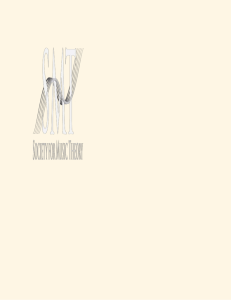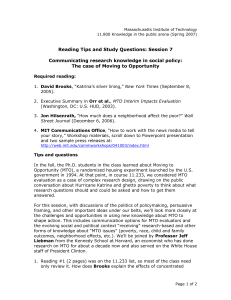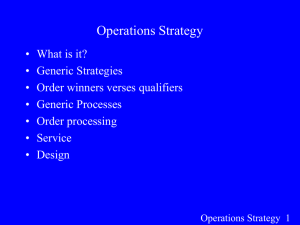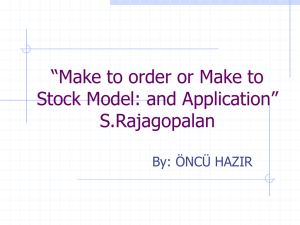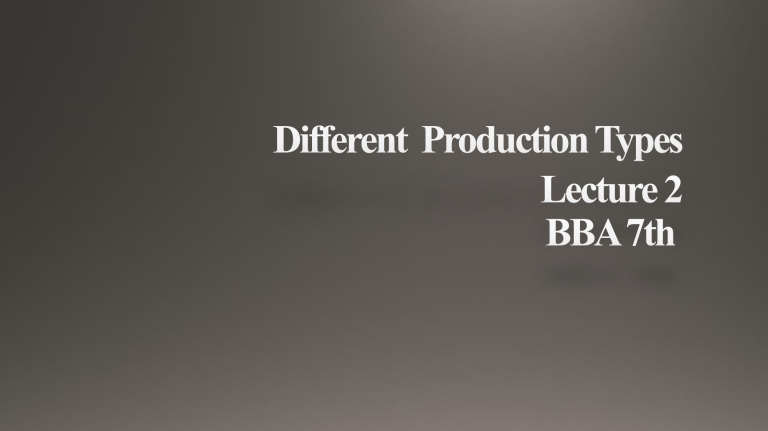
There are many production modes available and often the products or the market (customer demand) will determine which mode is required for a manufacturer. • Make to Stock (MTS) • Make to Order (MTO) • Assemble to Order (ATO) Make to Stock (MTO) is used for high volume goods, commodified products, consumables and other product types where consumers purchase the same version of a product as a single unit or in bulk. It is a “push” production method used to provide a steady supply and stock for retailers. • • • Produce finished goods; customer buys from inventory Advantage: Smooth production Disadvantage: Inventory • • • • • Service level (orders filled when requested) Inventory turnover (sales/avg. inventory) Back order fill rate Inventory accuracy Time to replenish • Make to Order (MTO) is a manufacturing mode where production begins once an order is received. It is a “pull” type production mode where demand in the form of an order triggers production. MTO is used on goods where the order is a quantity of one or a few and in situations where all or part of the order may be custom made or carry a high unit cost. Many of the components and raw materials may require sub processing or rendering before they find their way into the final product. • Start production when customer orders. • Advantage: No finished goods inventory • Disadvantage: Intermittent production Key performance measures – Lead time – Orders completed on time (or late) – Quality measures • Assemble to Order (ATO) may follow many of the same steps as Make to Order. However, in ATO, few, if any, sub-processes are required, and units are assembled from completed components to make a whole unit. • Make parts and subassemblies; finish when customer places order: • Advantages: Less inventory, faster service • Disadvantage: Some WIP inventory Key performance measures – Speed of service – Inventory levels – Quality of product and service • Advantages of MTO and ATO include: • Cost – Because there is little to no safety stock set aside to produce volume targets, and because the production environment does not require a large amount of WIP, cost of MTO and ATO is lower than some MTO modes. MTO and ATO environments require less cost in the form of raw materials warehousing space and staff. • Specialization – In MTO and ATO environments, orders can be made specific to customer requirements. • Finished Goods Inventory – In an MTO or ATO operation, orders produced are already sold. This prevents the manufacturer from having to carry slow or no-selling units. This impacts cost in the form of warehouse space and staffing for finished goods. It also impacts cash flow and tax liability as no unsold units are left to tie up valuable cash over time. • Low Supply – Since orders are produced as they are received, MTO and ATO does not have a ready supply of units for purchase. In strong seasonal demand or if a model or product becomes widely popular, the lack of current availability may result in lost sales. • Lead Time – As MTO and ATO are built on demand, lead times are longer for products than in an MTS. • To maximize the effectiveness of an MTO or ATO production mode, small to medium manufacturers should adopt best practices to realize benefits. These practices include things such as: • Robust ERP/MRP System – Since MTO and ATO modes are triggered and driven directly by sales orders, a robust ERP(Enterprise Resource Planning) or MRP (Manufacturing Resource Planning) system is required. The platform should have a strong linkage between its sales order and production planning functionality. • Materials Planning – MTO and ATO production modes are excellent for perishables, custom production, production with high unit cost, and production where materials are segregated and only used for the orders for one customer. However, this doesn’t mean that all components are segregated. • Cost – Modern ERP/MRP systems can roll up costs accurately for custom orders. This accuracy allows managers to focus on process improvements in measured labor, waste reduction, maintenance programs and others that will help lower variable cost for the products. • Scheduling and Planning – A strong scheduling and planning system available through ERP and MRP systems will help plan production schedules at optimum levels. For one, relying on common parts and materials as mentioned in Materials Planning above will allow consolidating or combining production orders within the production workflow.
